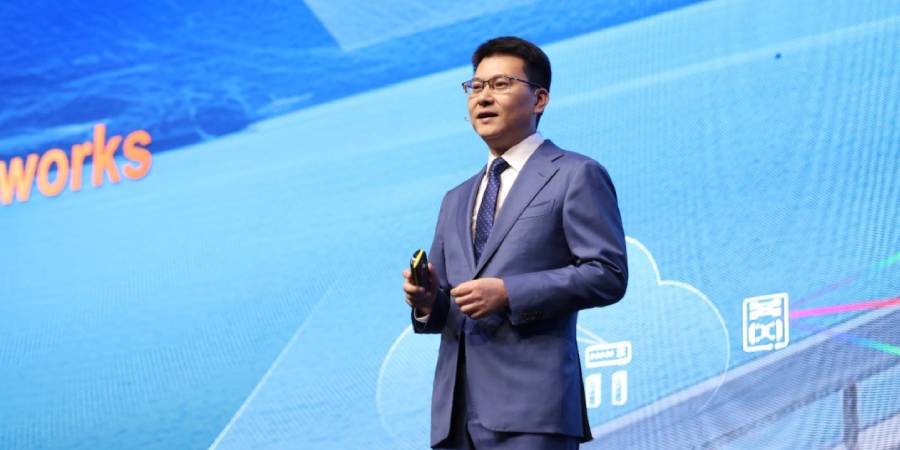During the 10th Ultra-Broadband Forum (UBBF 2024), Bob Chen, the President of Huawei's Optical Business Product Line, captivated the audience with his keynote address entitled "Building an AI-Centric F5.5G All-Optical Network for New Growth."
In his speech, Chen articulated the transformative role of artificial intelligence (AI) in today's technological landscape and how it fundamentally reshapes industries and everyday life.
The AI Revolution
Chen began by emphasizing that we live in an era where AI is not just an enhancement but a necessity. "Today, we have to say that AI is coming; AI is changing our life, work, and production," he noted, adding that, with over 1,300 developed and deployed foundation models, AI is becoming increasingly prevalent across diverse sectors.
These models revolutionize businesses and enhance personal experiences, such as travel planning, video creation, and quality inspections. He underscored the importance of AI integration in devices ranging from smartphones and personal computers to automobiles, asserting that future terminals will be fundamentally intertwined with AI capabilities.
Network infra of Carrier is crucial in the AI-driven age
Chen pointed out that carriers must adapt to the evolving landscape in telecommunications. Some will transition into comprehensive, AI, all-service providers, while others will forge partnerships with third-party companies to deliver AI computing and application services.
He stressed that building robust infrastructure networks and leveraging the synergy between computing and networking is crucial for business success in the AI-driven age. High bandwidth, low latency, and exceptional reliability are essential requirements for AI device-cloud interactions and intelligent computing training.
“Networks need to be upgraded in three parts. The first is bandwidth. AI applications require higher network bandwidth for multi-modal interaction. The second is latency. The device-cloud synergy mode of AI applications requires deterministic low latency. The third is reliability. Intelligent computing training and collaboration have higher requirements on network reliability,” he emphasized.
Huawei's Vision for F5.5G
To meet these demands, Huawei is committed to innovating its F5.5G technologies across various domains, including across its optical transmission, access, and management and control platforms. Chen mentioned that these innovations empower carriers to establish AI-centric, all-optical networks to drive efficiency and growth.
Advancements in Optical Transmission
In the realm of optical transmission, Chen showcased Huawei's pioneering optical switching technology, which has extended from traditional backbone networks to data centers (DCs) and metro edges. He noted that, this year, Huawei launched an all-optical switch solution for data centers. This cutting-edge solution enables substantial improvements in the scalability and efficiency of AI computing. The optical switching solution ensures scalable expansion, from 1,000 cards to millions, by utilizing ultra-dense ports and minimizing power consumption. Notably, the optical, module-free deployment approach results in a reduced failure rate of approximately 20%.
At the metro edge, Huawei’s all-optical switching technology facilitates low-latency networking through mesh configurations and one-hop connections. This infrastructure can establish latency circles of 1 ms, 5 ms, and 10 ms, ensuring an unparalleled AI experience for users. Chen proudly announced that over 50 global carriers have already implemented this technology to create high-performance metro networks.
Strategies for Monetizing Optical Access
Chen elaborated on three strategic avenues for monetizing fixed broadband:
- Coverage Monetization: With more than 28% of the global population lacking fiber connectivity, enhancing fiber coverage is essential to capitalize on the demographic dividend. Huawei’s solutions, including QuickConnect ODN and all-scenario AirPON, provide carriers with the tools necessary to construct networks quickly and affordably.
- Bandwidth Monetization: Many carriers are currently offering fiber broadband at lower speeds, undermining the potential benefits of optical fiber. Chen urged these carriers to gradually upgrade their service packages to better meet customer demands and maximize revenue potential. Moreover, he stressed that carriers providing gigabit services must transition from GPON to 10G PON to ensure high-quality experiences without interruptions.
- Experience Monetization: Chen emphasized the industry’s shift from Fiber to the Home (FTTH) to Fiber to the Room (FTTR) networking, which guarantees a superior experience for all users, regardless of time or location. With over 30 million global FTTR users already, Huawei is driving innovations through FTTR+X initiatives, and integrating AI to create advanced applications in the smart storage, home security, and healthcare sectors. The ultimate vision is to build an interconnected smart home ecosystem powered by a single FTTR network.
Enhancing Operational Efficiency Through AI
Regarding network management, Chen highlighted Huawei’s commitment to utilizing digital twins and AI foundation models to enhance operational efficiency and user experience. The Premium Broadband solution automates fault detection, enabling rapid diagnostics and proactive rectification of network issues, effectively reducing user complaints by 30%. The Premium Transmission solution similarly revolutionizes service planning, significantly cutting the time-to-market (TTM) for new services from months to hours.
Looking to the Future
In closing, Chen conveyed an optimistic vision for the future, predicting that the next decade will witness the widespread adoption of AI across all sectors. He reiterated Huawei's commitment to collaborating with industry partners to build a comprehensive AI-centric F5.5G all-optical network. This network will leverage advancements in optical switching, optimize optical access, and infuse AI capabilities into management platforms.
"The next decade will witness the fast popularization of AI," Chen stated. "Huawei hopes to work with industry partners to build an AI-centric F5.5G all-optical network, extending optical switching to data centers and metro edges; building premium networks for optical access by monetizing coverage, bandwidth, and experience; and fully injecting AI capabilities into the management and control platform. In this way, we can accelerate AI popularization and achieve new business growth together in the intelligent era!"
Through his keynote, Chen inspired attendees to embrace AI's opportunities, encouraging them to reimagine their business strategies and infrastructure to thrive in an increasingly interconnected and intelligent world.






